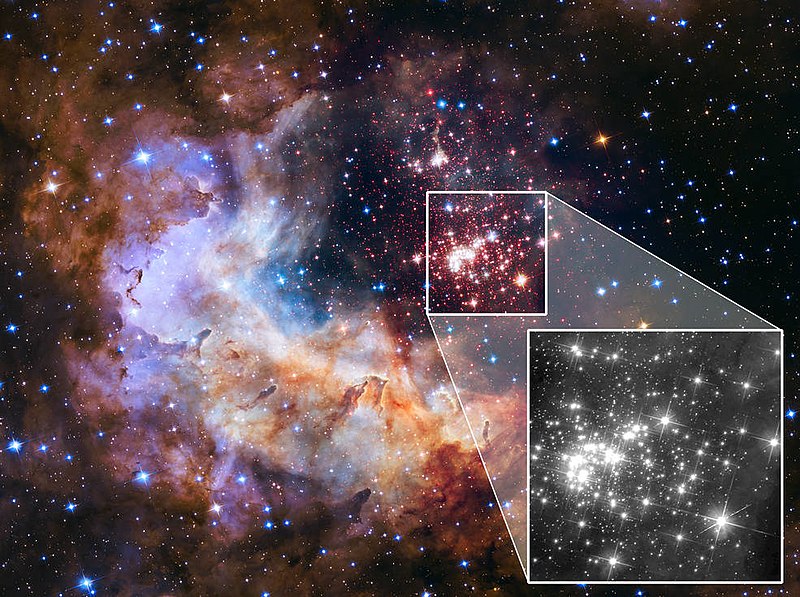File:Hubble Is Paving Scientific Paths for NASA’s James Webb Space Telescope (37466224842).jpg

Original file (985 × 735 pixels, file size: 217 KB, MIME type: image/jpeg)
Captions
Captions
Summary[edit]
| DescriptionHubble Is Paving Scientific Paths for NASA’s James Webb Space Telescope (37466224842).jpg |
NASA’s Hubble Space Telescope is helping identify potential celestial targets for the James Webb Space Telescope through a series of preparatory science observations to be completed before Webb is ready to make observations of its own. This preparatory science program began in 2016 in response to the desire of astronomers to use Hubble observations to set the stage for Webb. The program marked the first time astronomers were encouraged to submit science proposals for Hubble observations that could pave the way for Webb’s own observations. So far, 40 proposals have been approved. Using multiple observatories to analyze the same objects can identify aspects of those objects that using one observatory alone cannot. Hubble was designed to primarily observe the universe through visible light (though it is also able to see into the ultraviolet and near-infrared), while Webb is specifically designed to observe the universe in infrared light, through both direct imaging and spectroscopy. Spectroscopy measures the spectrum of light, which scientists analyze to determine physical properties of what is being observed, including temperature, mass, and chemical composition. Several preparatory science proposals in the program promise to use Hubble to deliver observational data Webb is not designed to collect. Hubble is able to see parts of the visible-light spectrum that Webb is not able to observe, and so it can fill potential observational gaps. For example, Hubble can examine exoplanets in light across the full electromagnetic spectrum available to it, with emphasis on the ultraviolet and blue wavelengths. Coupled with Webb’s infrared capabilities, both telescopes will deliver a more complete picture of the exoplanet systems. Other proposals have a goal of using Hubble to carry some of the workload for Webb, allowing astronomers to use their observation time with Webb more efficiently. Astronomers could use Hubble to survey multiple targets and determine the best strategy for Webb to perform further analysis. Depending on the data Hubble returned, astronomers would know to observe targets with Webb in a broad range of infrared wavelengths or to focus on smaller wavelength ranges, thus giving them a better starting point for their own observations. |
| Date | |
| Source | https://www.flickr.com/photos/nasahubble/37466224842/ |
| Author | NASA, ESA, the Hubble Heritage Team (STScI/AURA), A. Nota (ESA/STScI), E. Sabbi (ESA/STScI), and the Westerlund 2 Science Team |
Licensing[edit]
- You are free:
- to share – to copy, distribute and transmit the work
- to remix – to adapt the work
- Under the following conditions:
- attribution – You must give appropriate credit, provide a link to the license, and indicate if changes were made. You may do so in any reasonable manner, but not in any way that suggests the licensor endorses you or your use.
| This image was originally posted to Flickr by NASA Hubble at https://flickr.com/photos/144614754@N02/37466224842 (archive). It was reviewed on 13 July 2018 by FlickreviewR 2 and was confirmed to be licensed under the terms of the cc-by-2.0. |
13 July 2018
| Public domainPublic domainfalsefalse |
| This file is in the public domain in the United States because it was solely created by NASA. NASA copyright policy states that "NASA material is not protected by copyright unless noted". (See Template:PD-USGov, NASA copyright policy page or JPL Image Use Policy.) |  | |
 |
Warnings:
|
File history
Click on a date/time to view the file as it appeared at that time.
| Date/Time | Thumbnail | Dimensions | User | Comment | |
|---|---|---|---|---|---|
| current | 15:32, 13 July 2018 |  | 985 × 735 (217 KB) | Hiàn (alt) (talk | contribs) | Transferred from Flickr via #flickr2commons |
You cannot overwrite this file.
File usage on Commons
The following page uses this file:
Metadata
This file contains additional information such as Exif metadata which may have been added by the digital camera, scanner, or software program used to create or digitize it. If the file has been modified from its original state, some details such as the timestamp may not fully reflect those of the original file. The timestamp is only as accurate as the clock in the camera, and it may be completely wrong.
| Short title |
|
|---|---|
| Width | 2,568 px |
| Height | 1,904 px |
| Bits per component |
|
| Pixel composition | RGB |
| Orientation | Normal |
| Number of components | 3 |
| Horizontal resolution | 300 dpi |
| Vertical resolution | 300 dpi |
| Software used | Adobe Photoshop CC 2017 (Windows) |
| File change date and time | 11:43, 21 September 2017 |
| Exif version | 2.21 |
| Color space | sRGB |
| Date and time of digitizing | 08:49, 21 October 2005 |
| Date metadata was last modified | 07:43, 21 September 2017 |
| Unique ID of original document | uuid:F5D63E3643C011DA83F9C95696E3E828 |
| Copyright status | Copyright status not set |